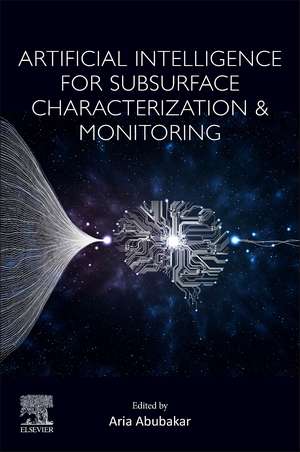Artificial Intelligence for Subsurface Characterization and Monitoring
Editat de Aria Abubakaren Limba Engleză Paperback – 22 ian 2025
The text is organized into five parts. The first two parts explore deep learning for data enrichment and well log data, including information extraction from unstructured well reports as well as log data QC and processing. Next is a review of deep learning applied to seismic data and data integration, which also covers intelligent processing for clearer seismic images and rock property inversion and validation. The closing section looks at deep learning in time lapse scenarios, including sparse data reconstruction for reducing the cost of 4D seismic data, time-lapse seismic data repeatability enforcement, and direct property prediction from pre-migration seismic data.
- Focus on deep learning applications for geoscience provides a one-stop reference for deep learning applications for geoscience.
- Comprehensive examples of the state-of-art techniques throughout the subsurface characterization workflow provide readers with a chance to familiarize themselves with deep learning applications not only in their own field of expertise but also in other relevant fields.
- All applications come with realistic field dataset examples so that readers can learn what to expect in real life.
Preț: 812.28 lei
Preț vechi: 990.58 lei
-18% Nou
Puncte Express: 1218
Preț estimativ în valută:
155.43€ • 162.72$ • 128.61£
155.43€ • 162.72$ • 128.61£
Carte indisponibilă temporar
Doresc să fiu notificat când acest titlu va fi disponibil:
Se trimite...
Preluare comenzi: 021 569.72.76
Specificații
ISBN-13: 9780443235177
ISBN-10: 0443235171
Pagini: 292
Dimensiuni: 152 x 229 mm
Greutate: 0.47 kg
Editura: ELSEVIER SCIENCE
ISBN-10: 0443235171
Pagini: 292
Dimensiuni: 152 x 229 mm
Greutate: 0.47 kg
Editura: ELSEVIER SCIENCE
Cuprins
Part I Deep learning for data enrichment
1. Rejuvenating legacy data by digitizing raster logs
2. Information extraction from unstructured well reports
Part II Deep learning applied to well log data
3. Well log data QC and processing
4. Automatic well marker picking
5. Automatic log interpretationPart III Deep learning applied to seismic data
6. Intelligent processing for clearer seismic images
7. Seismic interpretation with improved quality and efficiency
Part IV Deep learning for data integration
8. Automatic seismic-well tie
9. Rock property inversion and validation
Part V Deep learning in time lapse scenarios
10. Time-lapse seismic data repeatability enforcement
11. Direct property prediction from premigration seismic data
1. Rejuvenating legacy data by digitizing raster logs
2. Information extraction from unstructured well reports
Part II Deep learning applied to well log data
3. Well log data QC and processing
4. Automatic well marker picking
5. Automatic log interpretationPart III Deep learning applied to seismic data
6. Intelligent processing for clearer seismic images
7. Seismic interpretation with improved quality and efficiency
Part IV Deep learning for data integration
8. Automatic seismic-well tie
9. Rock property inversion and validation
Part V Deep learning in time lapse scenarios
10. Time-lapse seismic data repeatability enforcement
11. Direct property prediction from premigration seismic data
